How To Coach Your Clients To Transform Self Sabotage Into Self Mastery.
sent by Siddharth Anantharam | November 2, 2023
sent by Siddharth Anantharam
November 2, 2023
Why is it so challenging for people to make lasting changes, even when the stakes are sky-high?
One startling medical study revealed that even when heart doctors tell their seriously at-risk patients they could die without lifestyle changes, only 1 in 7 manage to transform their habits.
This study is proof that even a strong enough intention and sincere commitment to change often does not help.
The greatest gap in life is the one between knowing and doing. — Dick Biggs
The Struggle is Real: High-Performers are No Exception
You’d think high-performers—leaders, entrepreneurs, and coaches—would have it all figured out. I’ve seen it manifest over and over. Here are 3 different scenarios of clients (names changed) I have coached who fell trap to this.
- The Executive Leader — Sarah, was a C-suite executive who knew she needed to communicate more empathetically with her team to build trust. Yet, she fell back to a command-and-control style during high-pressure situations.
- The Time-Strapped Entrepreneur —Darren, an entrepreneur who wants to manage his time better. He even scheduled everything on his calendar but still doesn’t actually get down to completing it.
- The Aspiring Coach — Emily, a coach who has a vision for a dream project but consistently finds a new reason why it should be pushed or postponed.
In all 3 cases, the intent is high, the why is clear, yet the change seems to elude them.
The problem here lies in the gap between:
What we genuinely WANT vs What we DO to make it real.


As a coach, I’ve spent countless hours trying to understand this more deeply.
And I’ve realized that:
- If there is something we consistently want but never get done
- And we feel strong resistance and discomfort every time we try to get it done
Then, we are most likely self-sabotaging.
Unmasking The Enemy Within: Understanding Self-Sabotage.
Self-sabotage is NOT self-harm or being self-critical
Self-sabotage is simply the presence of a hidden sub-conscious commitment – an unconscious need that is competing for our energy and focus.


Without acknowledging this commitment and moving it from our unconscious into our conscious focus, we will only be treating the symptoms but not the real root cause of any problem.
In order to understand the root cause, we need to understand the hidden competing commitments that are actually stopping someone from achieving something they really want.
When we usually don’t do something we really want, we attribute it to procrastination or laziness. Or lack of clarity. Or a host of other reasons.
But as a coach, I know I have to scratch beyond the surface and dig deeper.
We often self-sabotage something we really want because we have a negative association between achieving the goal and being the kind of person who does.
Here are two simple examples:
Example 1: The Weight-Regain Conundrum:
Have you ever coached a client brimming with enthusiasm about losing 10 kilograms? They find a diet that promises the moon and the stars. Initially, the pounds start dropping; it’s like witnessing a small miracle. But then, shortly after reaching their goal, they gain back all the lost weight, and sometimes even more.


Example 2: The Financial Instability Loop
Let’s talk about Anna, a budding entrepreneur you may have encountered, who aspires for financial stability. She earns a decent income but ends up spending it faster than she can save. Luxurious vacations, high-end gadgets, you name it, she’s splurging on it.
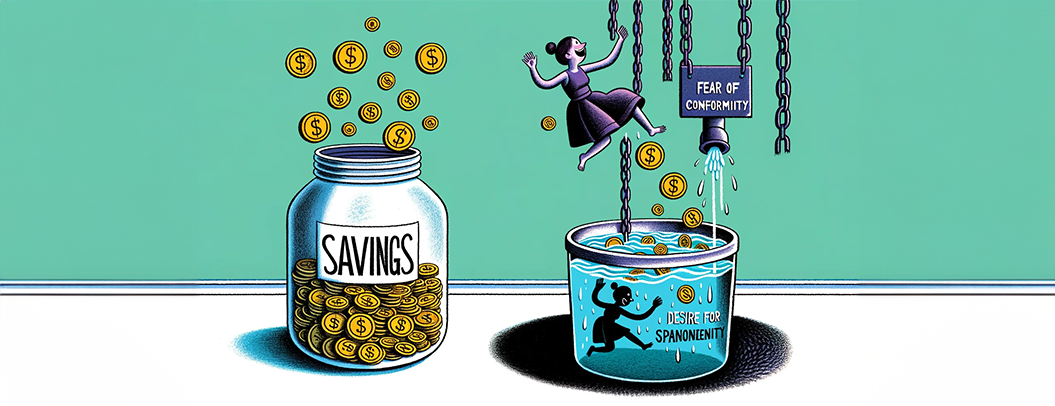
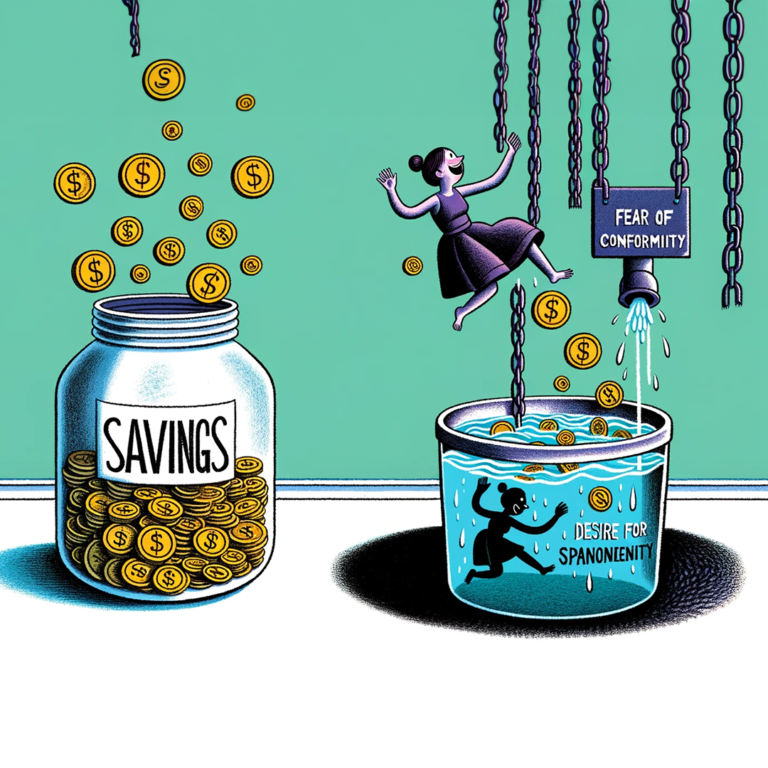
Hidden somewhere in both these scenarios is an ASSUMPTION or a BELIEF that is sub consciously protecting them from taking conscious action towards their goal.
Which is why as a coach if you only “coach the problem” without coaching the “person having the problem” you are missing out!

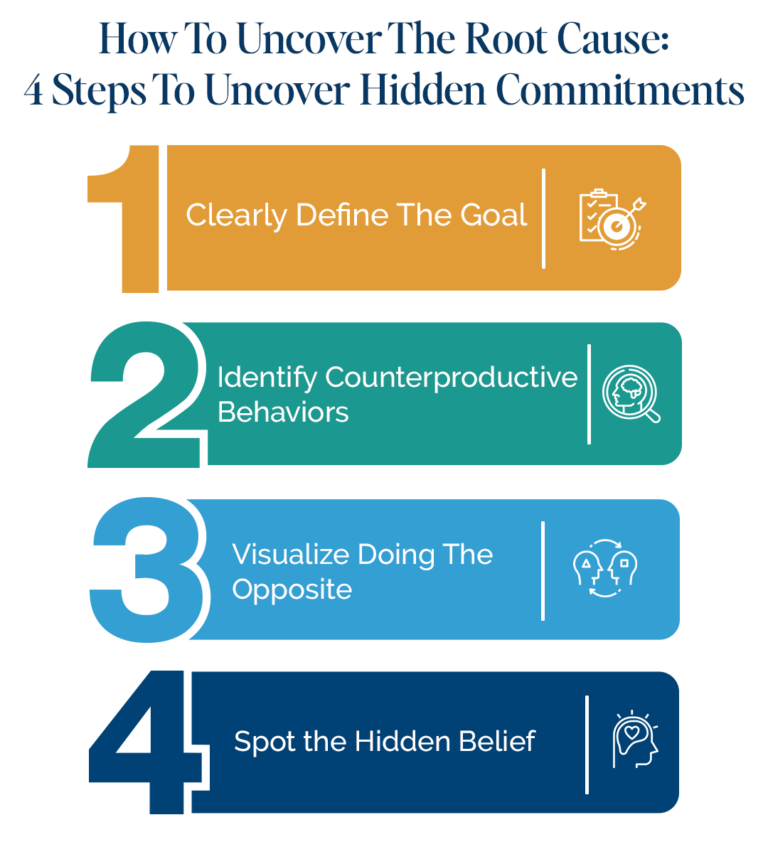
Harvard professors Robert Kegan and Lisa Lahey coined this phenomenon as “Immunity to Change,” a subconscious mechanism designed to “protect us,” sometimes to our own detriment.
Here is a simple 4 step inquiry process that helps you draw out a person’s competing commitment.
1. Clearly Define The Goal
Ask your client to clearly define what their Change or Improvement goal is.
It is very important to ensure that the goal is clearly defined and there is a strong commitment to make changes.
Why is this goal important for you and for the people you care about?
2. Identify Counterproductive Behaviors
What do they do or not do that stands in the way of their goal?
In other words, looking at his behavior, what does he do that is counterproductive or hinders the goal, or conversely what does he NOT do that if he did, would support the goal?
3. Visualize Doing The Opposite
Now, ask your client to imagine doing the opposite of what he says he does, or does not do. Does he feel any discomfort, fear or anxiety?
The intention here is to find out what the individual is protecting himself against.
For example, if he tends to bully his way into a conversation when his goal is to create a trusting relationship, how would it feel to take a step back and just listen? Is there discomfort in that? What emotions come up? What does he fear? What would be lost of his identity if he adopted this new behavior?
By continuing to do the harmful behavior or habit, what are you trying to protect yourself against?
4. Spot the Hidden Belief
Identify the core ASSUMPTION or BELIEF that’s driving their behavior.
Have them write this down clearly so it becomes a clear insight.
What are you learning about your hidden beliefs and assumptions through this exercise?
Once the hidden belief or assumption is uncovered, coach your client to check if it’s really true, if assuming it to be true is empowering them or disempowering them and how they could show up if they chose a more empowering belief that actually serves them.
3 Different Scenarios of Competing Commitments in Action
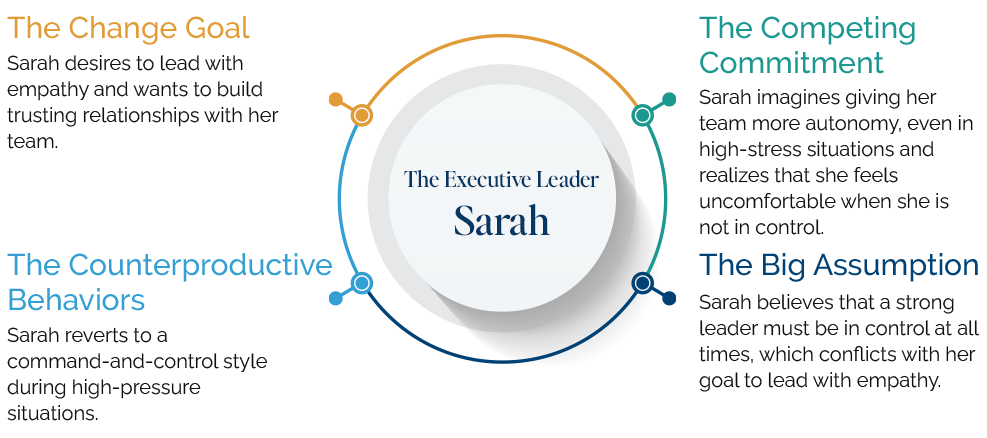
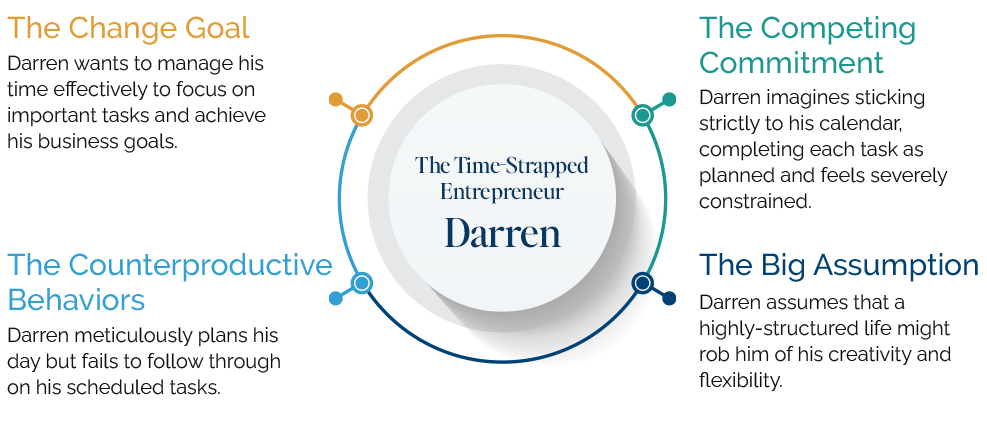
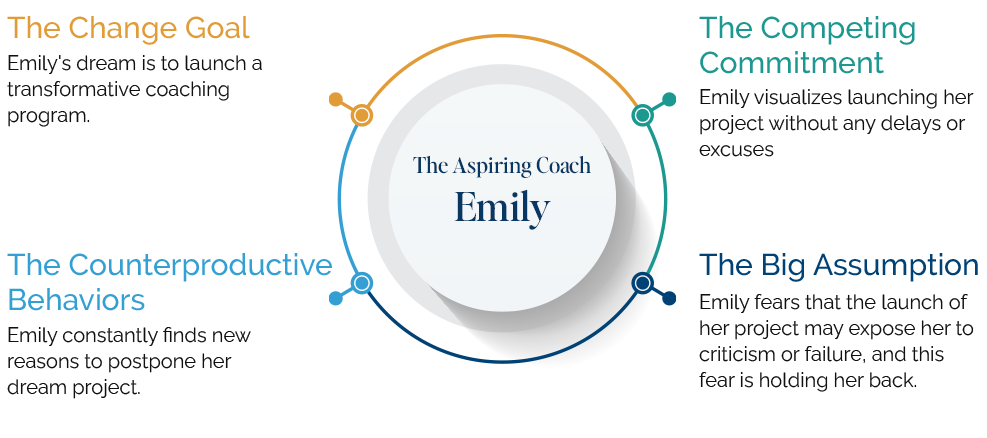
Until you make the unconscious conscious, it will direct your life, and you will call it fate. — Carl Jung
As coaches, we must go beyond coaching “the problem” and focus on coaching the “person with the problem.” Only then can we help our clients create breakthroughs and play a bigger, more impactful game in life.
By addressing these underlying beliefs and hidden commitments, we can guide our clients toward massive changes that don’t just stick for a moment, but for a lifetime.
What distinction resonates most with you in your coaching journey? Share your thoughts and let’s learn together.
Delivering one powerful coaching insight every Thursday morning.
Join a community of 5000+ coaches who Coach with Confidence. Every Thursday morning, you’ll get 1 actionable insight from me to master the art, science and business of coaching.
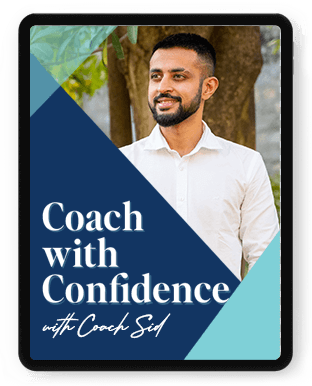
Leave a Comment Cancel reply
25 thoughts on “How To Coach Your Clients To Transform Self Sabotage Into Self Mastery.”
Comments are closed.

ABOUT THE NEWSLETTER
Join a community of 5000+ coaches who Coach with Confidence. Every Thursday, you’ll get 1 actionable insight from me to master the art, science and business of coaching.
READ PREVIOUS
OCTOBER 12
OCTOBER 5
September 28
September 21
September 14
September 7
September 1
August 24
August 17
August 10
July 28
July 20
July 14
June 23
May 25
May 18
May 11
May 4
April 27
April 20
April 13
April 6
March 30
March 23
March 16
March 09
March 02

Wow, fantastic weblog format! How lengthy have you been blogging
for? you make blogging look easy. The full look of your website is
wonderful, as well as the content material! You can see similar:
sklep online and here e-commerce
I blog often and I seriously appreciate your information. Your article has truly peaked my interest.
I am going to book mark your site and keep checking for new information about once per week.
I opted in for your Feed as well. I saw similar here: ecommerce and also here: sklep internetowy
Asking questions are in fact good thing if you are not understanding something fully, except this
piece of writing offers pleasant understanding yet.
I saw similar here: sklep internetowy and also here: najlepszy sklep
Thank you for the good writeup. It in fact used to be a entertainment account it.
Look complicated to more brought agreeable from
you! By the way, how can we keep in touch? I saw similar here: sklep online and also here: sklep internetowy
I all the time used to study piece of writing in news papers but now as I am a user of net therefore from now I am using net for articles,
thanks to web. I saw similar here: Sklep online
It’s awesome to pay a visit this web page and reading the views of all mates regarding this piece of writing, while I
am also zealous of getting know-how. I saw similar here:
Sklep online
Hello there! Do you know if they make any plugins
to help with Search Engine Optimization? I’m trying to get my blog to
rank for some targeted keywords but I’m not seeing
very good gains. If you know of any please share. Kudos!
You can read similar art here: Sklep internetowy
It’s very interesting! If you need help, look here: ARA Agency
Hi! Do you know if they make any plugins to help with SEO?
I’m trying to get my site to rank for some targeted keywords but I’m not seeing very good results.
If you know of any please share. Thanks! I saw similar
blog here: Backlink Building
If you would like to improve your know-how simply keep visiting
this website and be updated with the most recent news update posted here.
I relish, cause I discovered just what I used to be having a look for.
You’ve ended my four day long hunt! God Bless you man. Have a great day.
Bye
Wow, marvelous blog layout! How lengthy have you been running a blog for?
you make blogging look easy. The entire look of your website is fantastic,
let alone the content material! You can see similar here sklep internetowy
Wow, amazing weblog format! How lengthy have you been running a blog for?
you make blogging look easy. The overall glance of your website is magnificent, let
alone the content! I read similar here prev next and those
was wrote by Elena09.
Wow, marvelous weblog layout! How long have you been blogging
for? you make blogging look easy. The whole look of your site
is fantastic, as smartly as the content! I read similar
here prev next and those was wrote by Queen92.
Wow, marvelous blog format! How long have you ever been blogging for?
you make blogging look easy. The full glance of your web site is magnificent, as smartly as the content
material! You can see similar here prev next and
that was wrote by Robby02.
Wow, incredible weblog layout! How lengthy have
you been blogging for? you made running a blog look easy.
The entire look of your web site is magnificent, as smartly as the content!
I saw similar here prev next and those was wrote by Marquis74.
Wow, amazing weblog layout! How long have you ever been blogging for?
you made blogging look easy. The whole look of your website
is magnificent, as well as the content! I read similar here Carrie
Her8. 2024/04/23
Five Killer Quora Answers To Prettiest Pornstar prettiest
Pornstar
20 Trailblazers Lead The Way In Best Accident Attorney
fatal accidents attorney (Leslie)
15 Gifts For The Best Accident Attorney Near Me Lover In Your Life Accident
Attorneys nyc
20 Resources To Make You More Effective At Find Accident
Attorney Accident Attorney Nashville Tn (https://Blair-K.Co.Kr/)
The 10 Scariest Things About Attorney For Accident Claim attorney For accident
Claim
Attorneys Accidents Tips From The Top In The Business accident attorney new jersey – Adell –
You’ll Be Unable To Guess Only Fans Pornstars’s Tricks Only Fans Pornstars
Guide To Tiktokpornstar: The Intermediate Guide Towards Tiktokpornstar
tiktokpornstar